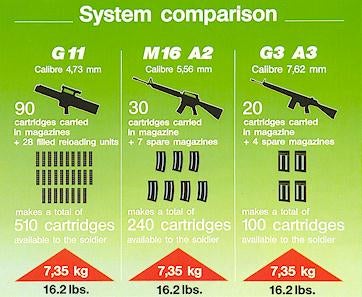KriegHund
Member
Back in the 1970's H&K devoloped the G-11. There were several problems, mostly complexity, ammunition expense, and
But that was 30 years ago. Weve made alot of advances, specificly in plastics and materials.
What im looking for is your expertise in such matters.
A) can we make the ammo cheaper?
B) can we make a simpler weapon (Maybe use regular box magazines so that the rounds can be fired normally rather than with a 90 degree roatating bolt?)
C) Can this gas seal problem be fixed?
Jim Keenan said:Antibubba asked, "How is a seal formed in the initial burn?"
That, as someone said, is the rub. A lot of methods have been tried but the simple fact is that the old fashioned cartridge case has proven to be the only way to get a really tight seal. And that is why dozens of "caseless" designs, dating back to the Volcanic, have failed. Even Daisy had a try at it, igniting their caseless round by air jet. Other ignition systems have been normal primers (the problem then is getting rid of the primer without it getting in the way), burnable primers, sparks, and fire from an external primer, very similar to a percussion gun (percussion revolvers used caseless cartridges quite similar to some of those tried recently).
The idea comes up again every so ten years or so and gun writers have a ball playing with the idea and copying predictions for the future from the manufacturer's brochure. But in the end, the lack of an effective breech seal has defeated them all. The other major problem is that caseless ammo tends to be fragile. Ammunition takes a heck of a beating under military storage and handling conditions and none of the caseless rounds tried so far has stood up to that kind of handling, not to mention the stresses and strains imposed on ammo in feeding through an automatic weapon. Lab tests by manufacturers can't begin to simulate real world conditions.
BTW, before someone reminds me, I am aware that big artillery pieces and naval rifles are "caseless", using bagged charges and a seal built into an interrupted thread breech. But those breech seals are big and require frequent replacement. Plus the guns are single shots, not repeaters or automatic weapons.
Jim
But that was 30 years ago. Weve made alot of advances, specificly in plastics and materials.
What im looking for is your expertise in such matters.
A) can we make the ammo cheaper?
B) can we make a simpler weapon (Maybe use regular box magazines so that the rounds can be fired normally rather than with a 90 degree roatating bolt?)
C) Can this gas seal problem be fixed?




